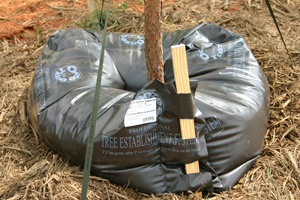Home > Planting trees > Establishing trees in the landscape > Irrigation > Irrigation management after planting
Irrigation management after planting
(see irrigation table below)
View an update on what we know and what we do not know about irrigating
trees after planting .
.
Regular irrigation after planting encourages rapid root growth that is essential for tree establishment. Irrigation helps maintain and encourage the desirable dominant leader in the tree canopy on large-maturing trees. Instead of a dominant leader, trees that are underirrigated during the establishment period often develop undesirable, low, codominant stems and double leaders that can split from the tree later.
Splits (so-called frost cracks or sunscald) along the lower trunk have also been associated with under-irrigation after planting (Ropolo and Miller, 2001). Since most root growth occurs in the summer months, irrigation during this time is crucial. You could loose almost an entire year's root growth if you under-irrigate the first summer.
 Unlike established plants, research clearly shows that recently transplanted trees
and shrubs establish quickest with light, frequent irrigation. For trees planted
in spring or summer, provide one (cooler hardiness zones) to three irrigations
(warmer hardiness zones) each week during the first few months after planting.
Daily irrigation in the warmest hardiness zones provides the quickest establishment.
Unlike established plants, research clearly shows that recently transplanted trees
and shrubs establish quickest with light, frequent irrigation. For trees planted
in spring or summer, provide one (cooler hardiness zones) to three irrigations
(warmer hardiness zones) each week during the first few months after planting.
Daily irrigation in the warmest hardiness zones provides the quickest establishment.
Following the initial few months of frequent irrigation, provide weekly irrigation until plants are fully established. At each irrigation, apply 1 to 2 (cool climates) or 2 to 3 (warm climates) gallons of water per inch trunk diameter (e.g. 2 to 6 gallons for a 2-inch tree) over the root ball only. We found that more was wasteful and that in the eastern US it was not necessary to apply irrigation to the soil around the root ball unless it was exceptionally dry..
In most landscapes that receive more than 30 inches of rain or irrigation annually, if the mulch area is maintained weed-free, irrigation does not need to be applied outside of the root ball. Never add irrigation if the root ball is saturated.
In cooler hardiness zones, in all but the driest years, irrigation on spring and summer planted trees can usually be discontinued once fall color has begun; irrigate fall planted trees several times and continue until foliage has dropped from the deciduous trees in the region. In warmer climates, irrigate fall and winter planted trees as described for the spring and summer planted trees.
In drier, desert climates there is benefit from applying additional irrigation outside of the root ball area. This is best done by filling a large diameter, four to six inches high, soil berm that holds water so it percolates into the soil. Irrigate twice each week through the spring, once per week in summer when monsoons arrive, then twice each week again in fall if it remains warm. Taper off to once or twice each month in winter and resume twice weekly next spring.
Water twice per month in warm weather in spring, summer, and fall and once or twice per month in winter in the first three to five years. Between years five and seven, water once every three weeks in warm weather and once every six weeks in winter. After this, the drought tolerant desert trees should be able to survive on natural rainfall.
| Size of nursery stock | Irrigation schedule for vigor 1,3 | Irrigation schedule for survival 2,3,4 |
| < 2 inch caliper | Daily for 2 weeks; every other day for 2 months; weekly until established. | Twice weekly for 2-3 months |
| 2-4 inch caliper | Daily for 1 month; every other day for 3 months; weekly until established. | Twice weekly for 3-4 months |
| > 4 inch caliper | Daily for 6 weeks; every other day for 5 months; weekly until established. | Twice weekly for 4-5 months |
Notes on Irrigation: (disclaimer on irrigation requirements)
|
||
These
guidelines are based on the following research: Beeson
and Gilman 1992; Gilman et al. 1994; Gilman and Beeson 1996; Gilman et
al. 1996; Gilman 2001; Gilman et al. 2002; Harris
and Gilman 1993; Watson
and Himelick 1982.

